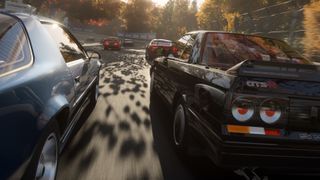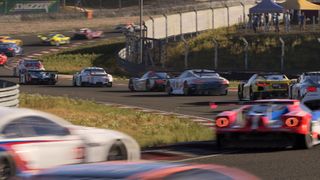Forget all that 'Car-PG' stuff, the AI is what makes Forza Motorsport worth playing
Dispatches from some of the most gloriously scrappy races in recent memory.

The stretch from the lights to the apex of turn two at Kyalami is a long one. Before you catch sight of the corner, you crest a hill and navigate ‘the kink’, a flat-out righthand turn that just barely qualifies as a corner. And then the road falls away just in time for you to see your doom: a long, downhill braking zone into the tight Crowthorne lefthander, almost a hairpin.
With a few races under my belt in Forza Motorsport already, I can say with 100% certainty that the run down to Crowthorne on lap one is going to be armageddon. It’s going to look like a scene in a mediaeval painting, cars strewn around the gravel trap like slain soldiers. Above all the other features Turn 10 has touted in the run-up to this big Forza relaunch, what really reinvigorates this game is how varied, ruthless, and downright reckless the AI drivers are.
Please don’t tone it down, Turn 10. I love it. I love to see drivers taking so many different lines into a corner, and then having to react to each other mid-turn while they’re unbalanced and off-camber. It’s great to observe AI drivers outmanoeuvring each other on corner exit and aggressively gunning it for overtakes on the straights.
My absolute favourite, though, is watching all the mistakes and crashes. You really get the sense that the drivers around you are pushing it to the limit, and even experimenting with different ways of achieving your shared goal: getting around this track really quickly.
And that’s because they are, of course. Previously in Forza games, not to mention racing games as a whole, the AI drivers just followed hand-drawn routes that a designer drew for them. A human being told them when to brake, when to steer, and when to hit the throttle. In Forza Motorsport 7’s case, those AI drivers could only apply 100% throttle or brake inputs: they couldn’t trail-brake into corners or apply progressive throttle to avoid traction loss. And they had about three racing lines to choose from per circuit, because that was the total number of lines that the designers created for them.
That gave FM7’s offline opponents three particular characteristics. They were predictable, they were slow, and they didn’t mess up. Driving past them felt like driving the morning commute in The Truman Show, hurtling past an eerie procession of equidistant vehicles going two abreast off the grid and along the straight.

So it goes in most driving games. The AI drivers aren’t really there to challenge you, or teach you lines. They’re mobile armco barriers to stop you spilling out of the corner and into the gravel. But this time they behave completely differently—because they’re built completely differently.
The biggest gaming news, reviews and hardware deals
Keep up to date with the most important stories and the best deals, as picked by the PC Gamer team.
There’s a bit of an AI revolution happening in racing games. Sony and Polyphony spent a huge amount of money developing Gran Turismo 7’s AI drivers using deep learning, MotoGP studio Milestone uses a similar technique called ‘neural AI’, and Turn 10’s been training its AI in a new way too.
Drivers—sorry, Drivatars—don’t follow a path created by a designer anymore. Instead they’re given a ton of information about the track, the conditions, and the car, and then they’re given about 26,000 hours to figure out how to drive around it really fast. That’s about a month solid.
So as I launch my Civic Type-R from the grid, through the kink at down to turn two at Kyalami, I’m not seeing AI drivers that have been designed to act more realistically. I’m watching 20 intelligent entities actually reacting to me and to each other in real-time, calculating how to make it through the pack and put in the fastest laps.
It’s not just a technological flex. I found my time with Forza’s preview build totally engrossing because of what that does to races. Drivatars have a choice of dozens of lines through each circuit now, lines they’re sussed out for themselves, and because they can now use those lines to battle each other more closely, I can pull off some even more audacious overtakes. I went in between two cars at Mugello, flat out, with all three sets of rear tires screaming for grip, and both cars left me enough space. It felt like one of the better passes in my virtual racing career.
This wouldn’t count for much if the handling didn’t feel so strong in the first place. FM’s revised handling model feels familiar, recognisably Forza, but it’s different enough that I can’t just rely on muscle memory to get around. Even in the performance class B category, my Civic could be a real handful and I found myself having to monitor its grip levels more closely than ever, paying close attention to weight transfer under braking so that the rear didn’t start snaking around and losing me time. This isn't suddenly Assetto Corsa—it’s a simcade racer designed primarily for controller inputs—but it’s demanding, and it feels rewarding to just run practice laps in search of better corner and sector ratings.
Forza Motorsport’s always been singularly good at gamifying the grindier elements of racing, and joining those sector ratings this time is the option to manually select your grid position for a bigger credits payout. If you’re feeling confident you can start from the back and earn a bigger bonus if you finish on the podium. And if you haven’t figured the track out yet, you can go easier on yourself and "qualify" higher up the grid, the tradeoff being a lower podium bonus.
I’m pretty excited for Forza Motorsport now. Those smarter AI drivers can make me faster, too. I can follow their lines and learn their tricks. I can pull off different kinds of overtakes that ordinarily would only come up in online races. And that to me matters more than the RPG-style progression for each car that Turn 10 has been talking up prior to release.
In an admittedly thin sliver of the full game I've previewed, progression seemed pretty straightforward to me—earning XP for doing basically anything on track levelled up my car, which unlocked parts, which in turn boosted that car’s performance rating. Ostensibly it goes deeper than that, letting you equip different loadouts for varied disciplines such as drift or endurance.
But that doesn’t get me going like a good scrap for track position into turn two at Kyalami. Only Forza’s chaotic opponents can do that.
Phil 'the face' Iwaniuk used to work in magazines. Now he wanders the earth, stopping passers-by to tell them about PC games he remembers from 1998 until their polite smiles turn cold. He also makes ads. Veteran hardware smasher and game botherer of PC Format, Official PlayStation Magazine, PCGamesN, Guardian, Eurogamer, IGN, VG247, and What Gramophone? He won an award once, but he doesn't like to go on about it.
You can get rid of 'the face' bit if you like.
No -Ed.
Most Popular

